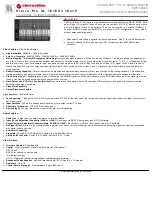
381
Configuring loopback detection
A loop occurs when a port receives a packet sent by itself. Loops might cause broadcast storms. The
purpose of loopback detection is to detect loops on ports.
With loopback detection enabled on an Ethernet port, the device periodically checks for loops on the
port. If the device detects a loop on the port, it operates on the port according to the preconfigured
loopback detection actions.
When the device detects a loop on an access port, it disables the port from forwarding data packets,
sends a trap message to the terminal, and deletes the corresponding MAC address forwarding entry.
When the device detects a loop on a trunk port or a hybrid port, it sends a trap message to the
terminal. If loopback detection control is also enabled on the port, the device disables the port from
forwarding data packets, sends a trap message to the terminal, and deletes the corresponding MAC
address forwarding entry.
Recommended configuration procedure
Step Remarks
1.
Configuring loopback detection globally
Required.
By default, loopback detection is disabled globally.
2.
Configuring loopback detection on a port
Required.
By default, loopback detection is disabled on a port.
NOTE:
Loopback detection takes effect on a port only after you enable loopback detection both globally and on the
port
.
Configuring loopback detection globally
1.
From the navigation tree, select
Security
>
Loopback Detection
.
The
Loopback Detection
page appears.
Summary of Contents for FlexNetwork NJ5000
Page 12: ...x Index 440 ...
Page 39: ...27 Figure 16 Configuration complete ...
Page 67: ...55 Figure 47 Displaying the speed settings of ports ...
Page 78: ...66 Figure 59 Loopback test result ...
Page 158: ...146 Figure 156 Creating a static MAC address entry ...
Page 183: ...171 Figure 171 Configuring MSTP globally on Switch D ...
Page 243: ...231 Figure 237 IPv6 active route table ...
















































